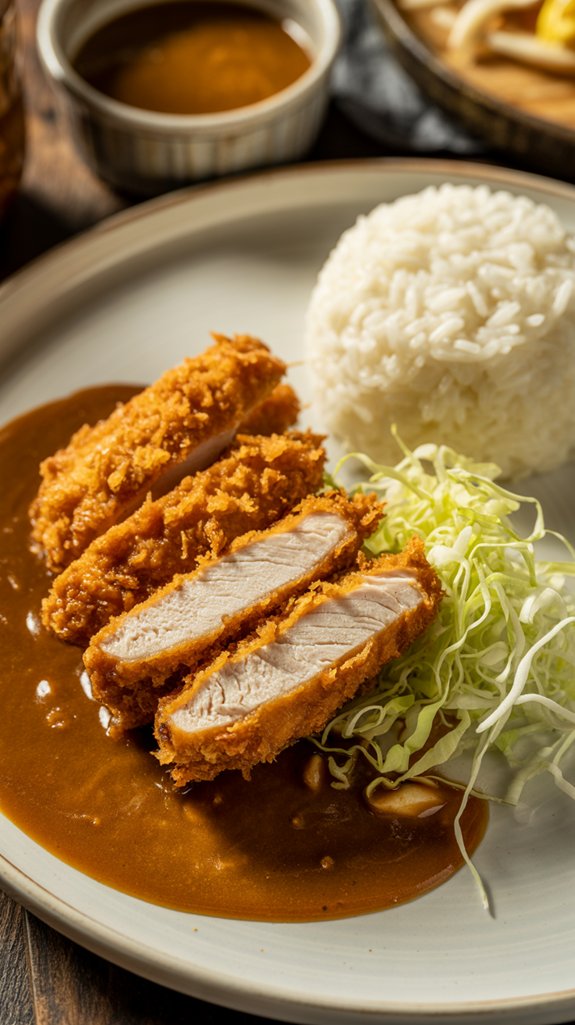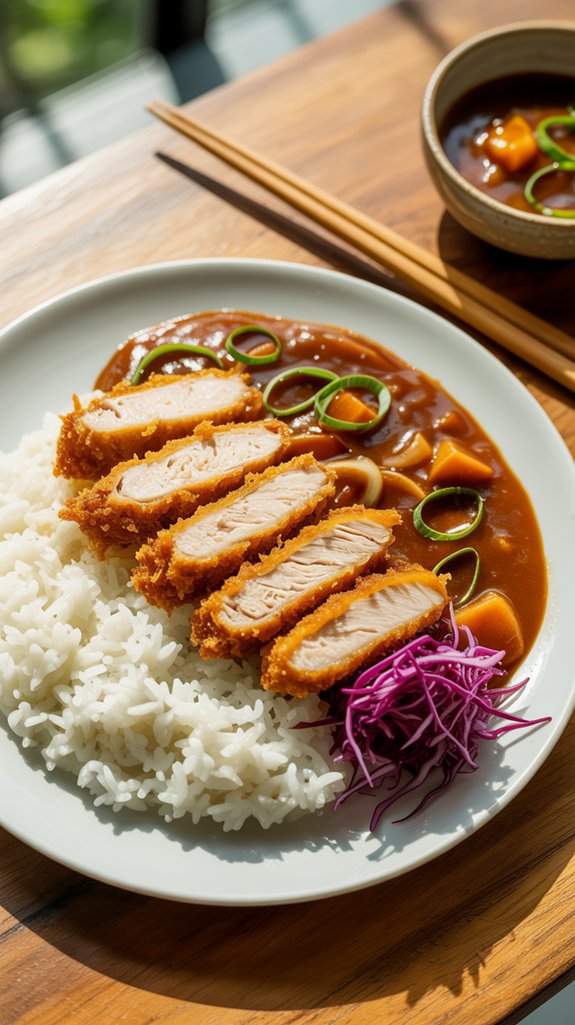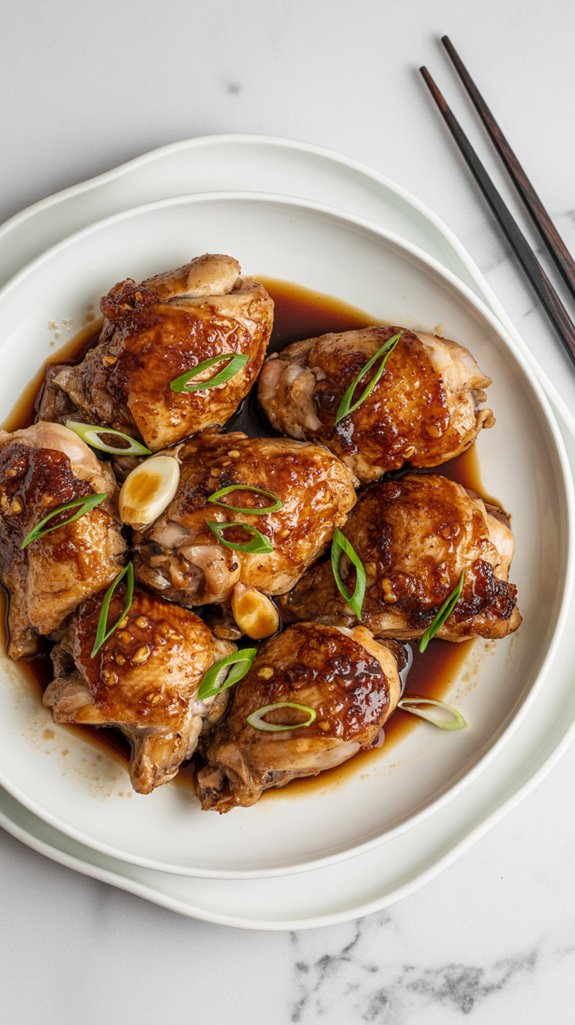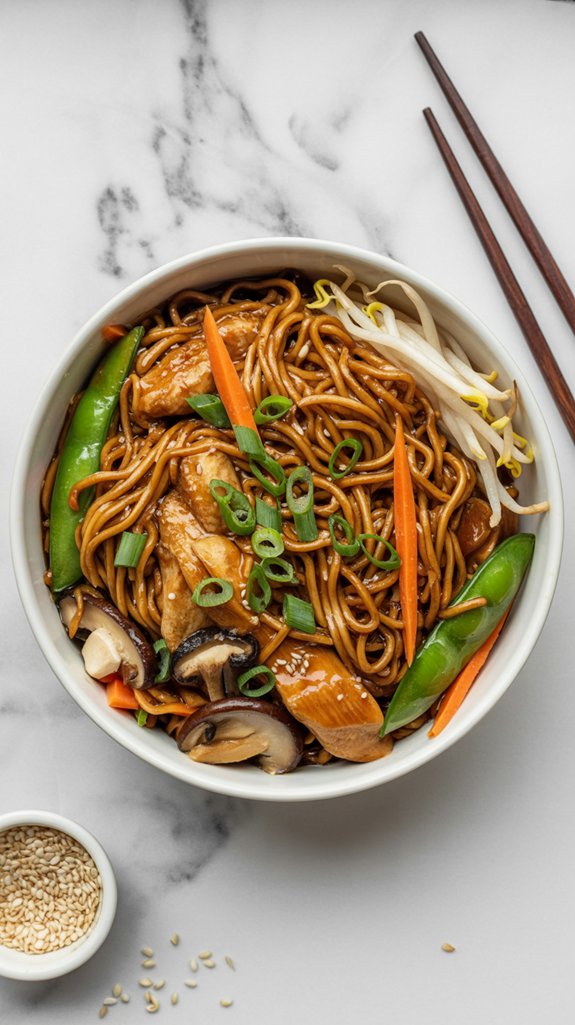Why You’ll Love This this Crispy Japanese Chicken Katsu Curry
This crispy Japanese chicken katsu curry brings together two comfort food favorites – golden, crunchy fried chicken and a sweet, mildly spiced curry sauce that’s honestly more approachable than intimidating.
The homemade curry sauce gets its unique flavor from an unexpected combo of apple, banana, and honey, creating that signature Japanese curry taste that’s way different from the fiery Indian curries you might be thinking of.
Plus, you get to play with your food a little by slashing the chicken breasts, dredging them in flour and breadcrumbs, then watching them transform into crispy golden perfection in the hot oil.
Ingredients List
You’ll need a mix of pantry staples and fresh ingredients to create this comforting Japanese-style curry that’s way more approachable than you might think.
For the Curry Sauce:
- 1 tablespoon butter
- 1 garlic clove, chopped
- 1 small onion, chopped
- 1 green apple, peeled, cored and diced
- 2 cups water
- 1 banana, sliced
- 1 tablespoon honey
- 1 teaspoon turmeric
- 1/4 teaspoon curry powder
- 1 tablespoon tomato ketchup
- 1 cup chicken broth
- 1 teaspoon salt
- 1 teaspoon black pepper
- 1 teaspoon cornstarch
For the Chicken:
- 4 chicken breasts, skinless and boneless
- 2 tablespoons flour
- 2 eggs, beaten
- 5 tablespoons breadcrumbs, dried
- 2 cups vegetable oil, for deep frying
For the Vegetables:
- 1 tablespoon butter
- 1 small onion
- 2 carrots, diced, boiled
- 2 potatoes, diced, boiled
Health Considerations:
- The deep-frying method adds significant calories and saturated fat, so consider baking the breaded chicken at 400°F for a lighter version
- The curry sauce gets natural sweetness from fruit rather than loads of sugar, which actually bumps up the vitamin content
- You can easily swap the white flour for whole wheat and use panko breadcrumbs for better texture and slightly more fiber
Step by Step Directions

Making this Japanese-inspired dish involves preparing three components that come together for a restaurant-quality meal at home.
Make the Curry Sauce:
- Melt butter in a saucepan and add garlic, onions, and diced apples.
- Cover and cook for 5 minutes until softened.
- Pour in 1 cup water and bring to a simmer.
- Stir in sliced banana, honey, turmeric, curry powder, and ketchup.
- Add chicken broth and bring to a boil, then season with salt and pepper.
- Mix cornstarch with remaining 1 cup water and add to the curry sauce.
- Simmer for 20 minutes, stirring occasionally.
- Strain the sauce through a large sieve or colander into a bowl, reserving the liquid.
Prepare the Chicken:
- Make two diagonal slashes across each chicken breast with a sharp knife.
- Coat chicken in flour on both sides.
- Dip each piece in beaten egg, then roll in breadcrumbs.
- Heat oil in a wok to frying temperature.
- Deep fry chicken two pieces at a time for 3-4 minutes until golden and crisp.
- Remove and drain on absorbent paper, keeping warm.
Make the Vegetable Curry:
- Melt butter in a separate saucepan.
- Add onions, boiled diced carrots, and boiled diced potatoes.
- Stir and fry for 5-8 minutes over moderate heat until beginning to turn golden.
- Pour in the strained katsu curry sauce and bring to a boil.
- Simmer for 4-5 minutes.
Serve:
- Slice chicken breasts into strips.
- Serve over steamed rice with the hot vegetable curry sauce alongside.
- For perfectly cooked rice every time, consider using a professional rice cooker to achieve restaurant-quality results.
Substitutions and Variations
Chicken Alternatives:
- Turkey cutlets work beautifully here, though they can be a bit thicker so you might need an extra minute of frying time.
- Pork chops, pounded thin, give you that same satisfying crunch with a slightly richer flavor.
- For a lighter option, try thick white fish fillets like cod or halibut, just be extra gentle when coating since fish loves to fall apart on you.
Curry Sauce Tweaks:
- Swap the green apple for a sweet Gala or Honeycrisp if that’s what’s rolling around your fruit bowl.
- No banana? A tablespoon of brown sugar or maple syrup adds that subtle sweetness the sauce craves.
- Bump up the curry powder to a full tablespoon if you want more of that warm spice kick, or throw in some garam masala for complexity.
- Coconut milk instead of some of the chicken broth creates a creamier, more indulgent sauce.
Vegetable Mix-Ups:
- Sweet potatoes instead of regular potatoes bring a lovely earthiness to the dish.
- Frozen peas or green beans, added in the last few minutes, give you some pop of color and freshness.
- Bell peppers or zucchini work well too, just remember they cook faster than the root vegetables.
Coating Variations:
- Panko breadcrumbs instead of regular dried ones create an even crispier, more restaurant-style coating.
- Mix some sesame seeds into your breadcrumbs for a nutty twist.
- Crushed cornflakes make a surprisingly excellent coating that stays extra crunchy.
Additional Things to Serve With This Dish
This hearty dish practically begs for some thoughtful sides that won’t compete with all that crispy, saucy goodness.
- Steamed jasmine or short-grain rice – Obviously the classic choice, and honestly, you need something to soak up every drop of that curry sauce because wasting it should be illegal.
- Japanese pickled vegetables (tsukemono) – Those tangy, crunchy pickles cut through the richness like a palate-cleansing miracle.
- Simple cucumber salad – Thinly sliced cukes tossed with rice vinegar, a pinch of sugar, and some sesame seeds for that cooling contrast.
- Miso soup – A light, umami-packed start that won’t fill you up before the main event.
- Shredded cabbage slaw – Raw, crisp, and often served alongside katsu in Japan, it’s like nature’s reset button between bites.
- Edamame – Because sometimes you need those little pops of green to make yourself feel virtuous.
- Steamed broccoli or snap peas – Keep them bright and barely cooked so they add color and crunch without getting in the curry’s way.
- Japanese potato salad – Creamier and slightly sweeter than the Western version, it’s comfort food that plays well with curry spices.
Cooking Tips & Tricks (Chef’s Notes)
Look, I’m going to level with you about the secrets that separate restaurant-quality katsu curry from the sad, soggy disappointments that haunt home kitchens everywhere.
- Double-fry your chicken for maximum crispiness – Fry once at 325°F for 3 minutes, rest for 2 minutes, then hit it again at 350°F for another 2 minutes, because nobody has time for limp breading that falls off like dandruff.
- Pound those chicken breasts to even thickness – Use a meat mallet or rolling pin to get them about ¾-inch thick, otherwise you’ll have some parts still clucking while others turn into hockey pucks.
- Let the breaded chicken rest for 10 minutes before frying – This gives the coating time to stick like it actually wants to be there instead of abandoning ship the moment it hits hot oil.
- Strain your curry sauce twice if you want it silky smooth – Once through a regular strainer, then again through fine mesh, because lumpy curry sauce is the enemy of elegance.
- Toast your curry powder for 30 seconds in a dry pan first – It wakes up those sleepy spices and makes them actually earn their keep instead of just sitting there looking pretty.
- Use panko breadcrumbs, not regular ones – Those fluffy Japanese crumbs create the kind of crunch that makes people close their eyes and make inappropriate sounds at the dinner table.
- Keep your oil temperature steady between 340-350°F – Too hot and you get burnt outsides with raw centers, too cool and you get greasy sadness that nobody deserves.
- Score the chicken breasts lightly before breading – Those little cuts prevent the meat from curling up like it’s trying to escape, plus they help the coating stick better.
- The secret to restaurant-quality katsu is in the prep work – our Japanese cooking techniques guide shows you how to butterfly chicken like a pro for that perfect even coating.
Nutritional Facts
Based on a serving size of 1 chicken breast with curry sauce and vegetables (serves 4):
- Calories: 685 per serving
- Protein: 42g (84% daily value)
- Total Fat: 28g (36% daily value)
- Saturated Fat: 8g (40% daily value)
- Carbohydrates: 65g (24% daily value)
- Dietary Fiber: 4g (14% daily value)
- Sugars: 18g (from apple, banana, and honey)
- Sodium: 1,240mg (54% daily value)
- Cholesterol: 165mg (55% daily value)
- Vitamin A: 184% daily value (from carrots)
- Vitamin C: 25% daily value (from vegetables and apple)
- Iron: 15% daily value
- Potassium: 890mg (19% daily value)
- Calcium: 8% daily value
Key Nutritional Notes:
- High in protein from chicken breast
- Significant vitamin A content from carrots
- Contains natural sugars from fruit ingredients
- Moderate calorie density due to deep-frying preparation
- Good source of potassium from potatoes and banana
Fun “Did You Know?”
While chicken katsu curry feels authentically Japanese, it’s actually a fusion dish that emerged during Japan’s Meiji period when Western influences flooded the country.
I find it fascinating that curry arrived in Japan via British naval officers who’d adopted it from India. The Japanese transformed this foreign dish into something uniquely their own by making it sweeter and milder.
Here’s what’ll surprise you: katsu curry wasn’t served in restaurants until the 1960s, yet today it’s one of Japan’s most beloved comfort foods.
Sometimes the best traditions come from unexpected cultural exchanges.





